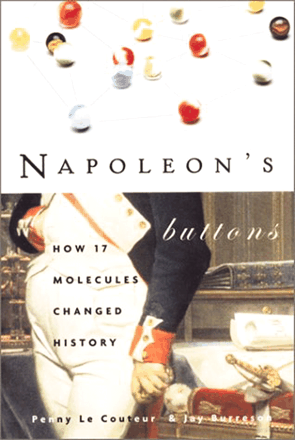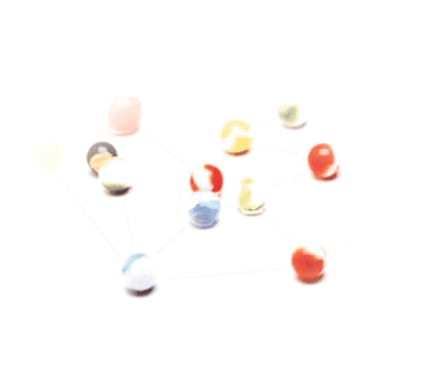Great Molecules in History
- Ken Moore, PhD
Napoleon’s Buttons. Penny Le Couteur and Jay Burreson. New York: Tarcher/Putnam; 2003. 375 pages. $24.95. ISBN: 585422207

When I received this book from a colleague known for his practical jokes, a quick glance at the title seemed to confirm that I was in for a gag. (I’m really not into reading books written by fashion designers and their ilk—and in this era of Velcro and zippers, who needs buttons?) But the small print under the title revealed that the book actually concerns, “How 17 molecules changed history.”
The main title derives from the hypothesis that tin buttons on the coats and trousers of Napoleon’s soldiers disintegrated in the intensely cold Russian winter of 1812. Consequently, the French soldiers had to clutch their coats around them for warmth and were therefore unable to handle their weapons effectively in battle. The use of tin thus allegedly led to the defeat of the Grande Armée, stopped Napoleon’s eastward expansion, and eventually brought an end to the French domination of Europe. This overly simplified scenario is reminiscent of the old nursery rhyme written by George Herbert (1593–1633), which begins, “For the want of a nail the shoe was lost/For the want of a shoe the horse was lost,” and ends with the loss of “the kingdom.” In a later chapter on isoprene and the role of cis and trans isomers in rubber, this analogy is carried further by relating how changes in temperature had plagued Charles Goodyear and Charles Macintosh in the development of tires and raincoats, respectively; more recently, the cold-related loss of pliability of a rubber O-ring is alleged to contribute to the fuel leak and tragic explosion on the space shuttle Challenger. (For the want of an O-ring…)
The authors thus posit that chemicals have played an essential but largely unrecognized role in the development of civilization. They support this thesis by compiling information on hundreds—not a mere seventeen—of natural and synthetic molecules into seventeen very readable chapters. Expanding on the fashion designer analogy, some of these deal with the chemistry and historical implications of cloth (e.g., cotton, rayon, silk, nylon, and dyes). Chapters dealing with food-stuffs (e.g., glucose, olive oil, and spices) and food preservation (e.g., refrigerants, and a particularly interesting chapter on salt) also constitute important sections of the book.
In the introduction, the authors provide some basic concepts of chemistry (bonds, structures, reactions) and in subsequent chapters they expand on this information and weave it into social and economic history using many delightful and informative anecdotes. My initial impression was that the review of chemistry was overly simplified, but as someone who took freshman chemistry over fifty years ago, I did find it a helpful entrée to fundamental details of the chemistry described in subsequent chapters. Indeed, there are numerous structural formulae, with clear descriptions of how minor changes in molecules alter their properties. In the chapter entitled Glucose, the reader is introduced to Fischer projection, Haworth formulae, and to the importance of α- and β- isomers in the condensation of monosaccharides into storage polymers (i.e., α-polysaccharides such as starch, glycogen, and amylopectin) and structural polymers (i.e. β-polysaccharides, such as cellulose and chitin). Some chapters (e.g., Silk and Rayon) contain details of structural chemistry, while others (e.g., Nitro Compounds) focus on chemical reactions. found the latter chapter informative for its historical development and discussion of the exothermic and volume-expanding reactivity of gunpowder, guncotton, and trinitrotoluene (TNT).
If structural chemistry is not your idea of a “good read,” there are many discussions that concentrate on the historic and economic importance of molecules. In the chapter entitled Peppers, Nutmeg and Cloves, for instance, we learn that the tasteless and sometimes rancid cuisine of medieval Europe spawned a demand for spices—especially for pepper, containing the “hot” molecule piperine—and ushered in the “Age of Discovery.” Specifically, the overland trade of spices from India, initially controlled by the Republic of Venice, distributed these valuable commodities throughout Europe, and so other states began to look for ways to compete in this very profitable business. The Portugese (Remember Vasco da Gama, ca. 1460–1524?) explored ways to round the southern tip of Africa to establish trade routes to India. Spanish ships attempted to reach the source of Indian spices by sailing westwards (so as to avoid Portuguese ports), but instead encountered the Americas. Ironically, the Spanish did discover varieties of chili peppers (containing another “hot” chemical, capsaicin) native to tropical America and Mexico, which were taken back to Europe and disseminated around the world.
Nutmeg and cloves, also much desired, were more rare than pepper. Although they come from plants indigenous to two distinct islands in the Moluccas (i.e., the “Spice Islands,” now part of Indonesia), their primary odors are due to two related molecules, eugenol (cloves) and isoeugenol (nutmeg), that differ only in the position of a double bond. Zigerone, which provides the unique flavor and aroma of ginger, and vanillin, the all-important ingredient in vanilla, have chemical structures closely related to those of eugenol/isoeugenol. In 1519–1522, Magellan, starting with five ships and 265 crewmen, reached the spice-producing areas of the Far East by sailing around the tip of South America. But his voyage was long and disastrous; the returning “flotilla” arrived in Spain with a cargo of spices, but consisted of a single surviving ship and a crew of eighteen. Although the spice trade was very profitable, individual voyages to the Far East (no longer by way of the Americas) remained financially risky. In order to reduce individual risks, merchants began to bid for “shares” of each voyage, eventually culminating in the birth of capitalism and the complex world economy.
Numerous ruthless battles among the Dutch, Portuguese, Spanish, and English were fought for control of the spice trade. The Dutch eventually monopolized the trade in cloves and nutmeg following the signing, in 1667, of a treaty in which the English gave up their claim to the nutmeg-rich South Sea island of Run in exchange for a then relatively unimportant island in the New World. Thus, the Dutch got nutmeg; the English got New Amsterdam (which they promptly renamed New York). The Dutch monopoly of trade in nutmeg and cloves did not last. Clove seedlings from the Moluccas and nutmeg trees form Run were smuggled out by the French and the English, respectively, and planted in their colonies.

Although all chapters contain some information on physiological, pharmacological, or toxicological properties, seven chapters deal specifically with chemicals that are of direct interest to pharmacologists/toxicologists: Ascorbic Acid; Wonder Drugs (on aspirin, sulfa drugs, and penicillin); The Pill (on sex hormones and other steroids); Molecules of Witchcraft (on herbals); Morphine, Nicotine and Caffeine; Chlorocarbons (including chloroform, mustard gases, and PCPs); and Molecules versus Malaria (on quinine and DDT). Although one might take issue with sometimes overly simplified comments related to pharmacological properties and mechanisms of action, these chapters are well done. I was intrigued to learn about the economic and social implications of these pharmacologically familiar compounds; indeed, many of the interesting anecdotes could “spice up” professorial lectures on these topics. For example, in Ascorbic Acid, the ravages of scurvy and the unsuccessful search for the antiscorbutic compound contained in fruits are described. In 1928, the important compound was finally extracted, not from fruit—in which high sugar levels precluded isolation—but from bovine adrenal cortex, and crystallized by a Hungarian biochemist, Albert Szent-Gyorgyi. Although “ignorant” of the structure, he recognized the molecule as a sugar-like hormone, and from the “-ose” ending for sugars suggested the name “ignose.” When this name was rejected by the editor of Biochemical Journal, Szent-Gyorgyi suggested “godnose.” The editor did not share Szent-Gyorgi’s sense of humor, and instead condoned the more conventional term “hexuronic acid.” Szent-Gyorgi was eventually able to obtain large quantities of hexuronic crystals from peppers (which lack sugars) from his native Hungary, and from these, Norman Haworth, a professor of chemistry at University of Birmingham, was able to determine the structure of ascorbic acid. In 1937, Szent-Gyorgi and Haworth were awarded Nobel prizes in medicine and chemistry, respectively. Haworth’s efforts to determine the cyclical structure of carbohydrates are described in the chapter entitled Glucose. This chapter also describes the condition of lactose intolerance, the biology of taste and sweetness, and the development of artificial sweeteners (e.g., saccharin, cyclamate, aspartame, and sucralose).
As was the case for spices, the development of other plant-derived products can be idiosyncratically linked to war. As described in Molecules and Malaria, the attempt by inhabitants of the eastern slopes of the Andes to maintain exclusive supplies of cinchona tree bark, the source of the valuable antimalarial quinine, was circumvented by Dutch smugglers. When the Dutch East Indies became occupied by Japan during World War II, both Germany and the US raced to develop synthetic antimalarials. A similar scenario arises in the Isoprene chapter, in which Hevea brasiliensis, a latex-producing tree indigenous to the Amazon basin, was smuggled out of Brazil to establish the European-colonized rubber plantations of what is now Sri Lanka and Malaysia. During World War I, the British blockaded rubber transport to Germany, thereby prompting German chemical industries to develop styrene and butadiene polymers. Similarly, during World War II, the Japanese occupation of the rubber-producing areas in South East Asia led US chemists to develop and produce massive amounts of synthetic rubbers.
This book will allow you to astound your friends, family, golf buddies, and bridge group with answers to a variety of questions, including why hardwoods are harder than softwoods; why rabbits eat their feces (not recommended for dinner conversation); why the name of the anti-pellagra vitamin nicotinic acid was changed to niacin (highly recommended for dinner conversation); why chlorofluorocarbons, which are chemically stable, destroy ozone in the stratosphere; and why silk is soft and comfortable in both warm and cool temperatures. In summary, this book is fascinating and informative, one you might place on your bedside table for an enjoyable read. Because each chapter is self-contained, you can read a section prior to falling asleep and then pick it up the next evening without having to review previous chapters. Thus, the book is appropriate for old folks with memory loss, short attention span, or a propensity for sleep! The book is also great for introducing the wonders of molecules to individuals who have little back-ground or interest in chemistry.
Penny Le Couteur, PhD, is a chemistry professor at a college in British Columbia, and Jay Burreson, PhD, is an industrial chemist and manager of a high-tech company in Oregon.
- © American Society for Pharmacology and Experimental Theraputics 2004



